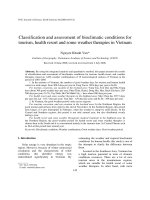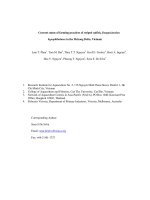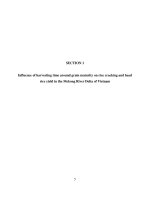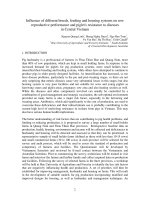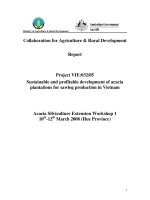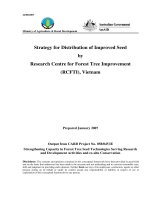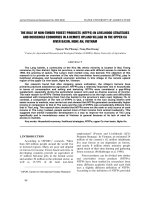Topic Culture Shock Of Foreigners Toward Vietnam.pdf
Bạn đang xem bản rút gọn của tài liệu. Xem và tải ngay bản đầy đủ của tài liệu tại đây (7.64 MB, 24 trang )
<span class="text_page_counter">Trang 1</span><div class="page_container" data-page="1">
<b>MINISTRY OF EDUCATION TRAININGTHUONG MAI UNIVERSITY</b>
<i><b>NGUYEN THỊ HONG NHUNGTRUONG MANH QUANGNGUYEN MINH TU QUYENLE THI THANH THUYLE THI NGOC TRAMNGUYEN TRUNG TRUCTRIEU LE VAN (Leader)</b></i>
</div><span class="text_page_counter">Trang 2</span><div class="page_container" data-page="2"><i><b>* The task of each group member:</b></i>
toward 7/9 Online The leader creates
content for the presentation. Give a
detailed outline.
Leader Complete
8/9 Online Create presentation ideas and assign members tasks. A deadline is set
by the leader.
Leader Complete
16/9 Online The members have finished the essay portion, which included
PowerPoint concept submissions.
members <sup>Complete</sup>
25/9 Online The leader writes the
group minutes report. <sup>All</sup>members <sup>Complete</sup>
</div><span class="text_page_counter">Trang 3</span><div class="page_container" data-page="3"><b>Full NameContentsMark</b>
<i><b>NGUYEN MINH TU QUYEN</b></i> Define the concept of culture shock
<i><b>TRIEU LE VAN </b></i> Represent causes of culture shock for foreigners in Vietnam <sup> </sup>
<i><b>NGUYEN HONG NHUNG</b></i> Describe the most common cases that represent cultural shock in Vietnam
<i><b>LE THI THANH THUY</b></i> Describe the impact of culture shock
<i><b>TRUONG MANH QUANG</b></i> Represent ways to solve and
overcome culture shock
<i><b>LE THI NGOC TRAM</b></i> Describe the assessment of culture shock.
<i><b>NGUYEN TRUNG TRUC</b></i>
Summary of the culture shock of foreigners towards Vietnam
</div><span class="text_page_counter">Trang 4</span><div class="page_container" data-page="4">II.CULTURE SHOCK OF FOREIGNER TOWARDS VIETNAM...6
1. Definition...6
2. Causes of culture shock for foreigners in Vietnam...7
2.2. Communication and language...8
2.3. Customs and habits...9
2.4. Food habits...11
3. The most common cases represent cultural shock in Vietnam...12
3.1 Vietnam dishes...12
3.2. Customs and traditions...15
4. The impact of culture shock on ex-pats...16
4.1. Negative effects of culture shock...16
4.2. Three possibilities for humans after culture shock...17
4.3. Experiences and lessons learned after culture shock...17
5. Ways to solve and overcome culture shock...18
5.1. Learn and study about the local culture...18
5.2. Communicate and establish connections with locals...20
5.3. Self-awareness and flexibility in adaptation...20
6. Assessment of culture shock...21
</div><span class="text_page_counter">Trang 5</span><div class="page_container" data-page="5">Reason for choosing the topic
Vietnam is topic forming into a well-liked travel destination for visitors from abroad because of the growth of its economy and tourism. However, in addition to the advantages of seeing new places, exposure, and learning about other cultures to gain more experiences, outsiders also face a significant challenge: cultural shock. We chose this topic for everyone to have a better understanding of what culture shock is, its causes, its effects on foreigners, how to deal with it, and how to get over it. Understanding culture shock promotes integration and variety in society while making the environment more welcoming for visitors. The report's goal is to assist foreigners in understanding culture shock better so they can prevent confusion if they encounter it.
</div><span class="text_page_counter">Trang 6</span><div class="page_container" data-page="6"><b>II.CULTURE SHOCK OF FOREIGNER TOWARDS VIETNAM1. Definition</b>
Culture shock is precipitated by the anxiety that results from losing all our familiar signs and symbols of social intercourse. These signs or cues include the thousand and one ways in which we orient ourselves to the situations of daily life: when to shake hands and what to say when we meet people, when and how to give tips, how to give orders to servants, how to make purchases, when to accept and when to refuse invitations, when to take statements seriously and when not. Now these cues, which may be words, gestures, facial expressions, customs, or norms are acquired by all of us while growing up and are as much a part of our culture as the language we speak or the beliefs we accept. All of us depend for our peace of mind and our efficiency on hundreds of these cues, most of which we do not carry on the level of conscious awareness.
Some of the symptoms of culture shock are excessive washing of the hands; excessive concern over drinking water, food, dishes, and bedding; fear of physical contact with attendants or servants; the absentminded, far-away stare (sometimes called the tropical stare); a feeling of helplessness and a desire for dependence on long-term residents of one’s nationality; fits of anger over delays and other minor
</div><span class="text_page_counter">Trang 7</span><div class="page_container" data-page="7">frustrations; delay and outright refusal to learn the language of the host country; excessive fear of being cheated, robbed, or injured; great concern over minor pains and eruptions of the skin; and finally, that terrible longing to be back home, to be able to have a good cup of coffee and a piece of apple pie, to walk into that corner drugstore, to visit one’s relatives, and, in general, to talk to people who make sense.
<b>2. Causes of culture shock for foreigners in Vietnam</b>
<i><b>2.1. Cultural and historical differences</b></i>
Vietnam has a rich history and diverse cultural heritage, which can shock foreigners when they are exposed to historical and cultural relics. Understanding and appreciating their value can be challenging for foreigners. This is due to different points of view and knowledge of Vietnam's history and culture.
Vietnamese people have many different customs and traditions compared to Western countries, such as:
Touching another person's head is considered disrespectful.
When going to the temple, you need to wear discreet clothes, do not wear short skirts or off-the-shoulder shirts.
During meals, Vietnamese people often use chopsticks to eat, not knives and forks.
Vietnam has a long and turbulent history, with many struggles for independence and national unification. Foreigners may feel overwhelmed when learning about Vietnamese history.
</div><span class="text_page_counter">Trang 8</span><div class="page_container" data-page="8"><i><b>2.2. Communication and language</b></i>
Language is an essential component of communication and cultural understanding. Foreigners in Vietnam may face problems and surprises due to differences in linguistic communication and understanding. Being unable to understand or participate in regular discussions and communication can lead to feelings of loneliness and powerlessness. Foreigners find it difficult to find a Vietnamese individual who speaks English fluently to talk with them, and many signs are only printed in Vietnamese, making it impossible to learn about local culture. Communication and social interaction rules differ from country to country. Communication style differences can lead to awkward and uncomfortable circumstances for both parties.
Vietnamese is a difficult language to learn, with a complex grammar and pronunciation system. Foreigners often have difficulty communicating with Vietnamese people, especially in situations where there is no interpreter.
In addition, Vietnamese also has many words and phrases with meanings typical of Vietnamese culture. These words can be misunderstood or difficult for
</div><span class="text_page_counter">Trang 9</span><div class="page_container" data-page="9">foreigners to understand. For example, the word "anh" in Vietnamese can be used to address a male friend, lover, or husband.
<i><b>2.3. Customs and habits</b></i>
Traffic chaos
In Vietnam, traffic congestion is common in major cities such as Hanoi and Ho Chi Minh City. Traffic bottlenecks arise for a variety of reasons, the most common of which is an excess of personal vehicles, particularly motorcycles. As a result, most tourists who visit Vietnam are quite surprised and find it unusual. Littering
Have you ever wondered why our country's environmental conditions are always dirty compared to developed countries in the world? What is the cause of such a big difference? Much of it belongs to people's consciousness. In foreign countries, after eating, they always throw it in the trash. Therefore, people who do cleaning work are often very leisurely. Meanwhile, in our country, the complete opposite is true, the roads are full of plastic bags... making our country's image worse in the eyes of international friends.
</div><span class="text_page_counter">Trang 10</span><div class="page_container" data-page="10">High price pressure
One problem that causes culture shock to foreigners is price pressure. Taking a taxi at a high price, buying food at a high price, and being forced to buy food... are situations that tourists encounter when coming to Vietnam.
In Western countries, price gouging is often considered a disrespectful act to sellers. However, in Vietnam, price gouging is a fairly common practice, especially in markets and small stores.
Vietnamese people often have the mentality of wanting to buy goods at the cheapest price possible. Therefore, they will often try to negotiate prices with sellers. Squeezing high prices is considered a way to demonstrate the ingenuity and negotiation skills of shoppers. Differences in ideas about price gouging can make foreigners feel uncomfortable, even offended.
Environment
</div><span class="text_page_counter">Trang 11</span><div class="page_container" data-page="11">The environment in Vietnam also has many differences compared to the environment in Western countries. Some notable differences include:
The environment in Vietnam is often crowded and noisy. The environment in Vietnam is often polluted.
The environment in Vietnam often has many insects.
These differences can make foreigners feel uncomfortable and tired. For example, as the environment in Vietnam is often crowded and noisy, foreigners may feel pressured and stressed. As the environment in Vietnam is often polluted, foreigners may feel short of breath and tired. As the environment in Vietnam often has many insects, foreigners may feel uncomfortable and get bitten by mosquitoes.
<i><b>2.4. Food habits</b></i>
Unique dish
Dog meat: Dog meat is a popular dish in Vietnam but is considered a banned dish in many Western countries.
Insects: Eating insects is a popular culinary culture in many Asian countries, including Vietnam. However, insects are a rather strange and even scary dish for Westerners.
Blood pudding: Blood pudding is a dish made from the blood of animals, usually pigs or ducks. This dish is considered a delicious and nutritious dish in Vietnam but is considered a horrible and disgusting dish to Westerners. When visiting Vietnam, Westerners may find it difficult to eat. To begin with, eating dog meat is still a thing. Dogs are considered close friends in other countries. When they arrived in Vietnam and saw the dog meat restaurants and drinks, they were shocked and surprised.
</div><span class="text_page_counter">Trang 12</span><div class="page_container" data-page="12">Some foreigners may struggle to adjust to Vietnam’s food safety norms and requirements. The fact that food is prepared right on the sidewalk, using food of unknown origin, using food containing toxic substances is everywhere, is widely sold publicly and consumers still must deal with it every day. use without knowing or having to accept it.
Drinking culture
Drinking alcohol is a tradition of Vietnamese people, drinking alcohol to confide, talk and discuss business matters with partners. However, alcohol is sometimes abused. Anyone who does not drink alcohol will be laughed at and considered impolite, especially men. Because of this, many people try to drink alcohol to show their strength and masculinity.
<b>3. The most common cases represent cultural shock in Vietnam</b>
<i><b>3.1 Vietnam dishes</b></i>
When it comes to food, Vietnamese never ceases to attract scores of patrons with some of the best tasty treats. Besides mouthwatering delights, Vietnamese cuisine also boasts some of the world’s weirdest foods that will give you serious goosebumps. From rare street snacks, spooky bugs, and fresh animal organs to the beating heart of a deadly snake. You name it, Vietnam’s got it.
</div><span class="text_page_counter">Trang 13</span><div class="page_container" data-page="13">• Vietnamese offal stew (Phá lấu) – the most exotic Asian stew
Speaking of Vietnamese street food, Phá lấu is always on top of the list. Phá lấu – also known as Vietnamese offal stew – is a popular Vietnamese street treat traditionally made from cow, pig, or duck organs. This delicacy best highlights the Vietnamese attitude to food: nothing goes to waste. Every part of an animal is utilized.
The animal’s offal parts such as lungs, intestines, and livers are first carefully washed with salted water, then boiled with ginger to get rid of the organ’s awful smell. Next, they are stewed in a special authentic spice blend. The broth is rendered with coconut milk for richness. Annatto powder is indispensable since it gives the dish its signature red and orange tone.
Offal stew is best enjoyed with Vietnamese bread (Banh mi). Some eateries also serve it with instant noodles. Visually, the dish may not look so appetizing. However, the flavor is unreal. Different animals come in different flavors. In general, the soup is rich, well-seasoned, and creamy with a pleasant odor. The long-shimmered organs, cooked to perfection, are extremely juicy, and chewy. There is an additional dipping sauce that adds a pungent relish.
• Fried crickets (Dế chiên) – a must-try in your adventurous eating
</div><span class="text_page_counter">Trang 14</span><div class="page_container" data-page="14">Insect – it is not what most people would invite someone for a meal. The idea of making these six-legged creatures as dishes is frightening, except for bugs-eating enthusiasts.
But in Vietnam, and other parts of Asia, insects are a fantastic ingredient for scrumptious treats, for those who are brave enough to try. The most common insect used in the odd side of Vietnamese cuisine is cricket.
With the ingenuity and creativity of Vietnamese, there are dozens of unique delicacies made from crickets. One of the most iconic dishes from these tiny insects is fried crickets.
Crickets are seasoned with salt, pepper, and other strong seasonings, then fried in hot oil, along with minced pork and lime leaves. The flavor of crickets is quite similar to shrimp or crab, but much crunchier and chewier. With the strong seasoning as an enhancement, it turns out that fried crickets taste amazing.
Studies have shown that crickets are an excellent source of nutrients, providing protein, healthy fats, and vitamins. It is also believed that eating crickets can cure rheumatism and obesity. So, if you are new to creepy crawling insects, crickets are the perfect start! It can be daunting at first, but you may get addicted after one bite.
• Sandworm pancake (Chả rươi) – the world’s most peculiar pancake Sandworms are a local specialty of Hai Duong province in Northern Vietnam. The sandworms are raised in ponds just like shrimps in agricultural areas. These little creatures are super rich in protein. Normally, vendors would cook the dish using frozen sandworms. However, to taste the best of sandworm pancakes, you should get them at eateries cooking with fresh raw worms.
The sandworms are not mixed in the batter. The chef will put some batter on the pan heavy in hot oil. Then, the raw worms are put right on top of the cooking batter. Watching the sandworms moving in the pan while being cooked will excite you to crave the dish even more. With the nice crunchy texture combined with the savory taste, you will be shocked by how delicious this street snack is. It is the best unique way to get some protein in your diet but also still be able to enjoy delicious pancakes.
</div><span class="text_page_counter">Trang 15</span><div class="page_container" data-page="15">• Weasel poop coffee!
As its instinct, the weasels climb from trees to trees to find only the best and ripest coffee berries to eat. Unlike the rodents that eat the fruit’s flesh and trigger off the seeds, the weasels just slightly chew the berries’ flesh and swallow the beans.
Once the berries get into the weasel’s stomach, the flesh will be digested but the beans are synthesized with digestive acids and enzymes in the animal’s stomach. During that process, the bitterness of the bean is mostly eliminated, while the enzyme chemicals are absorbed in the beans making the coffee beans less caffeinated.
Because of how weasel picks the ripen berries, weasel coffee is a natural selection of high-quality beans. Once roasted, they become more aromatic with the vanilla smell. Therefore, weasel coffee generally tastes smooth and earthy with caramel chocolate flavor.
<i><b>3.2. Customs and traditions</b></i>
Superstition plays a major role in Vietnam. There are people all over the world who have a lucky routine or a particular thing that brings them good luck. In Vietnam, superstition is more important than the odd idiosyncrasy. It plays a role in everyday life for things as important as health.
• Strong superstition:
For generations, one of the ways to keep a child healthy has been regarded as a particular necklace that will keep away evil spirits. Similarly, there are days of a particular month, a particular number that someone might feel is unlucky; that someone is unlikely to do much that day and will certainly not go to work.
Few in rural Vietnam understand modern sciences so perhaps it is natural that superstition is still strong; after all, 80% of the population still live and work in rural areas where their ancestors lived before them. Superstition manifests itself in such important ways that it will prevent a betrothal if the woman was born in the
</div>

